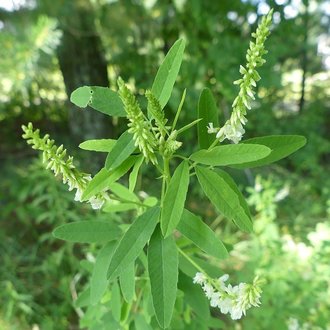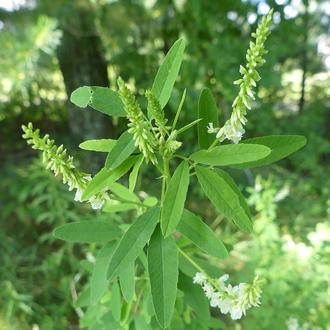White Sweetclover (Melilotus albus )
Also classified as Melilotus alba.
↑Summary
An introduced, nitrogen-fixing biennial, mostly found in open, disturbed sites, establishing on exposed soil.
↑Habitat
Mostly found in open, disturbed sites, including grasslands, roadsides, railways, fallow fields, industrial sites, and in sunny riparian areas. Typically colonizes bare, exposed soil. In forested parts of North America, where exposed soil is uncommon, this plant is mostly limited to disturbed, anthropogenic habitats, but in more arid regions, able to invade natural spaces such as open grasslands and open riparian woodlands. Also occasionally found in well-drained margins of marshes, including freshwater and brackish marshes. Also found on exposed soil mounds formed from anthills or by digging mammals.
Moisture is required for this plant to germinate and establish, but established plants tolerate drought. Tolerates a range of soil conditions, from slightly acidic (pH > 5.5) to alkaline, fine-to-coarse-textured soils. Often more abundant on calcium-rich soils. Tolerates moderate levels of soil salinity, to the point where it can be found growing on sites where some salt crystals are visible on the soil surface.
Habitat is similar to and overlapping with yellow sweetclover, but this species prefers slightly cooler, moister sites, and is less tolerant of the most extremely dry or nutrient-poor soils. It is also more tolerant of temporary flooding.
Mostly limited to early-successional habitats, except in the hottest, driest climates where it occupies a later successional stage. The successional stage this plant occupies is brief, and its populations tend to vary greatly from year-to-year, exploding temporarily in response to disturbance and then plummetting in its absence.
↑Faunal Associations
This plant is eaten by a number of native herbivores, including deer, antelope, elk, and rabbits. It is also consumed by livestock when it grows in pastureland, although it seems to be preferred by native herbivores more than by livestock; the plant is somewhat toxic to cattle.
The seeds are eaten by numerous native birds, but may not be a preferred food source. Birds also utilize the plants for nesting and cover.
The flowers attract bees, including many native bees, mostly halictid bees. Overall, the two sweetclover species support much more insect biodiversity than is typical for introduced species, and this species supports even more than yellow sweetclover.
↑Uses
Historically, this plant has been used medicinally, including to produce an anticoagulant (blood thinner.)
After it was introduced, Native Americans began to use this plant in herbal teas. The pleasant-smelling flowers were also used both by European settlers and native Americans to scent linens and sleeping quarters.
This species is also used in land reclamation. It has good potential to aerate compacted soil, and as a nitrogen fixer, it increases nitrogen availability for other species. Its presence on some sites is self-limiting, and it can sometimes hinder the establishment of other, more invasive introduced species. However, its use for this purpose is regionally-dependent, and in other areas, primarily the western parts of the Midwest and Great Plains, it is itself considered invasive. In areas where it fixes nitrogen faster than native plants, including much of the arid West, it it can facilitate the establishment of other invasive species.
↑Related Plants
At least seven Melilotus species have been introduced to North America; there are no native species in this genus. However, the broader Trifolieae tribe contains both native and introduced species.
This species is closely related to yellow sweetclover (Melilotus officinalis), which is easily distinguished by its flower color. Some sources, including the USDA PLANTS database, lump these two species together, treating them as varieties. However, we defer to the FEIS article which treats these as separate species, citing sources that assert that the species are genetically incompatible, and have been regarded as separate species for over 200 years.
↑Links & External Resources
• Melilotus albus | Go Botany (About This Site)
• Melilotus albus | Missouri Plants (About This Site)
• White Sweetclover | Maryland Biodiversity Project (About This Site)
• Melilotus albus Medikus (White Sweet-clover) | Digital Atlas of the Virginia Flora (About This Site)




